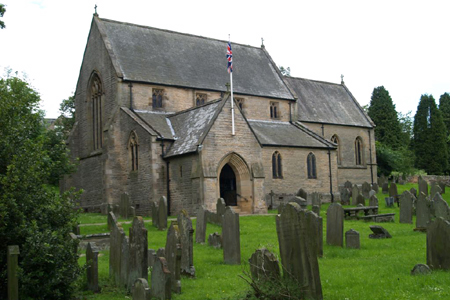 |
||||||||||
 |
||||||||||
|
1471: St Mary the Virgin, Middleton-in-Teesdale, England Mystery Worshipper: Patara. The church: St Mary the Virgin, Middleton-in-Teesdale, England. Denomination: Church of England. The building: The present building, the work of the architect C Hodgson Fowler, dates from 1878 and replaces a medieval church which, in turn, had evidently taken the place of an even earlier edifice. The exterior is in the Late Decorated style and features a separate bell tower. Inside can be found a beautiful wooden reredos and some fine stained glass, traditional choir stalls, lectern, pulpit, wooden pews, and many "Sacred to the memory of ..." plaques. The church: This is the largest parish area-wise in England, although thinly populated. The vicar looks after three churches and is also a schoolteacher. Judging from the parish magazine, there is quality if not quantity, with a good deal of action in the local community. The neighbourhood: Middleton-in-Teesdale, in County Durham, is unique. It is situated on the Pennine Way, generally regarded as the toughest, most demanding, and most challenging long-distance walking trail in Britain, and is much visited by folk in walking boots, waterproofs and rucksacks. The surrounding countryside is spectacular, with breathtaking scars (local name for cliffs/ravines), several significant reservoirs, waterfalls including High Force (where the whole of the River Tees plunges over a precipice in two stages), grouse moors, sheep and cattle farms. In the 19th century Middleton was a lead mining centre; much deprivation followed when this abruptly ceased. Tourism is now the chief industry. The cast: The Revd Amanda Pike, vicar, celebrated and preached. Two ladies whose names I did not gather read the Old and New Testament lessons, and another lady administered the chalice. The date & time: Fathers Day, 17 June 2007, 11.00am. What was the name of the service? Holy Communion Order 1. How full was the building? Much less than half full; there were four or five children and about a dozen adults. Did anyone welcome you personally? Yes, one or two people spoke to me as I arrived. A stranger was very conspicuous. Was your pew comfortable? Wooden pews, not overly comfortable but it was OK. The hymn book didn't fit the ledge, and mine fell off with a loud crash quite early in the service. How would you describe the pre-service atmosphere? Much talking, people greeting each other as happens in a small community. What were the exact opening words of the service? "Good morning and welcome to our service on the second Sunday of Trinity." What books did the congregation use during the service? Common Worship Holy Communion, Hymns Old and New, and a very efficient pew sheet containing readings for the day and events for the week ahead. What musical instruments were played? Organ. I didn't check its age or provenance. The organist wasn't young but he kept going regardless and held everything together for the hymns. The kindest thing to say about the singing is that it was valiant. Did anything distract you? The notice board listed the vicar as "Revd ASG Pike." "What a proper masculine name," I thought, and was surprised to find out that the vicar was in fact female. Was the worship stiff-upper-lip, happy clappy, or what? Formal Church of England, as you would expect with Order 1. Exactly how long was the sermon? About 12 to15 minutes – my concentration began to waver towards the end. On a scale of 1-10, how good was the preacher? 9 – Her accent was northern and a little difficult for me to follow, but I was delighted to find she was clearly audible. In a nutshell, what was the sermon about? God as Father. It was Fathers Day and the gospel was Luke 15:11-32, the parable of the prodigal son. The vicar began by speaking of the fairy tale "The Three Little Pigs" (in order no doubt to attract the attention of the children in the congregation) and how insubstantial their house must have been. But our heavenly Father's house is permanent, and all within it are valued. The father in Luke's gospel loved his errant son so generously that he ran out to greet him while he was still some distance away. God loves us ever so much more generously than even that. Which part of the service was like being in heaven? I enjoyed the hymns (though I did feel I was singing solo), because it was the book we use in my home parish and they seemed apt. And which part was like being in... er... the other place? I always feel uneasy in an unfamiliar church when it comes to exchanging the peace. What happened when you hung around after the service looking lost? No embarrassment. I had a talk with one lady who I think was the mother of the children present. She was friendly and interested in why I was there. Also I spoke with the vicar and found her very informative and dedicated (and also I suspect very busy). How would you describe the after-service coffee? No coffee. Everyone dispersed as far as I was aware. How would you feel about making this church your regular (where 10 = ecstatic, 0 = terminal)? 10 – I loved the way the vicar celebrated holy communion and felt this was a real act of worship. Did the service make you feel glad to be a Christian? Yes, it was uplifting and I emerged feeling restored. What one thing will you remember about all this in seven days' time? How much I enjoyed it. |
|
|
||||||||||||||||||||||||||||||||||||
| More Mystery Worshipper reports | |||||||||||||||||||||||||||||||||||||||
 |
|||||||||||||||||||||||||||||||||||||||






